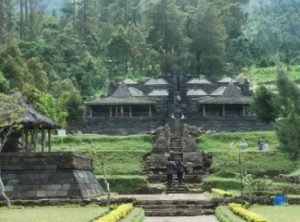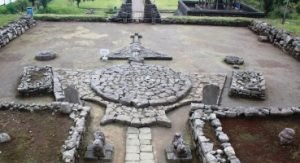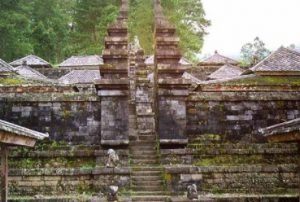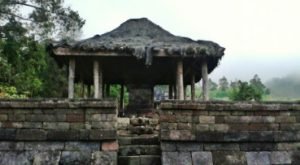History of Cetho Karanganyar Temple - Origin and Temple Architecture
The history of Cetho Temple is one unique temple that you must visit when in Central Java. Candi Centho is located in Gumeng Village, Karanganyar District, Central Java. This temple is a Hindu temple is quite famous in Java. Cetho Temple is quite unique because it is located on the plateau with an altitude of about 1400 mdpl. This sejarha site also has a history similar to other temples located not far from Sukuh Temple. Both of these temples are located in Karanganyar regency of Central Java. This article will discuss in detail about the history of cetho temple including its origin, its invention and its uniqueness of architecture.
Cetho Temple name is taken from the mention of the surrounding community of this temple where this name is actually also the name of the village where the temple was built namely Dusun Cetho. In Javanese, cetho has a clear meaning. Named cetho because if you are in Dusun Cetho, you can clearly see the mountain scenery around this village. These mountains include Mount Merbabu, Mount Lawu and Mount Merapi plus the peak of Mount Sindoro and Mount Sumbing. In addition to views of the mountains, from this hamlet you can also see clearly the sighting of the city of Surakarta and the city of Karanganyar underneath. According to historians, Cetho Temple was built in the 15th century, as well as Sukuh Temple.
This temple was built in the period of Majapahit Hindu Kingdom. The uniqueness of this temple is Cetho Temple memiki different architecture with other Hindu temple temple in Java. Cetho temple has an architecture like punden berundak, in contrast to the architecture of the temple in general. This architectural difference because this temple was built at the end of the glory of Majapahit Kingdom, where this kingdom is now going to collapse. With the collapse of the Majapahit Kingdom, the original culture of the surrounding community re-emerged. Therefore, Cetho Temple architecture represents the original culture of the community around Dusun Cetho. [1]
Rediscovery of Cetho Temple
Historically, the rediscovery of Cetho Temple was first performed by a Dutch historian named Van de Vlies. He found Cetho Temple in 1842. In addition to Van de Vlies, there are several historians and other experts who have conducted research on Cetho Temple namely AJ Bennet Kempers, KC Crucq, WF Sutterheim, NJ Krom and Riboet Darmosoetopo of Indonesian nationality.
After the first discovery and research of the experts, in 1928 Cetho Temple was excavated again. From this excavation, it is known that Cetho Temple was built at the end of Majapahit which is around the 15th century. Since the rediscovery of Cetho Temple, many tourists who have visited this temple because of its unique architecture compared to the temple in general. In addition, because of its location in the highlands make Cetho Temple has a view of the mountains that are able to attract the hearts of tourists.
Architecture of Cetho Temple
As mentioned earlier, Cetho Temple has a unique architecture of punden terraces. The history of Cetho Temple is built with andesite stone material using a simple relief, unlike other Hindu temples that have complex reliefs. Cetho temple has an architecture similar to the Maya temple in Mexico and the Incas in Peru. The statue contained in this temple was when viewed not similar to the Javanese but similar to the Sumerian or Roman.
The uniqueness of this architecture makes a debate among historians about the year he made this temple. Looking at the architecture, Cetho Temple could have been made long before the Majapahit Kingdom. Andesit materials used in Cetho temple is different from the Hindu temple in the Majapahit kingdom which at that time was built using red brick. Meanwhile, the reliefs that exist in the temples in the Majapahit Kingdom era are also more complex and detailed, in contrast to the reliefs found in this temple which tend to be simpler and very easy to recognize.
In the beginning, Cetho Temple has 14 terraces with terraces located along the west to the east of the temple. However, only 13 terraces remain after its discovery. And unfortunately again, after the restoration, only the remaining 9 terraces that can now be seen by the visitors of the Temple. Here is a description of the architecture of the terrace at Candi Cetho.
- Terrace 1 Cetho Temple
Terrace 1 in Cetho Temple is actually just a page. As you walk towards this one terrace, you will see 12 stone statues called Nyai Gemang Arun. Inside this terrace you will find a large gate with a shape like temple bentar. The shape is like a temple that you may encounter on the island of Bali.
Inside the terrace 1, you will also see a building like a pendopo without walls on the southern part of terrace 1. This building has a foundation with a height of 2 meters. At the top of the pendopo there is a stone base that is often used to put offerings by people who come at that time.
- Terrace 2 Cetho Temple
Before reaching terrace 2, you will see gates and stairs made of stone. Right beside this ladder, there are two statues called Nyai Agni. Unfortunately, one of the statues of Nyai Agni has been damaged. Like the terrace 1, terrace 2 also has a form like a yard. The difference is, in the back of the terrace 2 you can see the expanse of rocks arranged to form the image of the eagle. The arrangement of these rocks forms the image of an eagle that is winging its wings.
In Hinduism, the eagle is the vehicle of Lord Vishnu which also symbolizes the world over. At the end of the two eagle wings form sunlight. This light will also be found in the section to Garuda. In the back, you can see the stone is arranged with the shape of a turtle turtle. This turtle turtle symbolizes the incarnation of Lord Vishnu representing the underworld. In addition, there are also triangular images and Kalacakra or male genitals. Because of this picture also, Cetho Temple is also often called the Temple Lanang or Candi Laki Laki. In the picture this picture can also be seen other animal forms such as crabs, mimi and frogs. This symbol symbol is probably a number of sengkala in the year Saka 1373 or 1451 AD.
- Terrace 3 Cetho Temple
The third terrace is also shaped like a yard. In the 3rd terrace of Cetho Karanganyar Temple you can see 2 buildings that were built without walls. In this Pendopo building you can see a stone table that may be used as offerings.
In this stone table there are reliefs of people and animals are quite simple. As mentioned earlier, the relief in Cetho Temple is simpler than the reliefs in other Hindu temples that tend to be more detailed.
Terrace 4 Temple Cetho
As you go to the 4th Terrace of Cetho Temple, you will see the arrangement of stairs that look very neat. It can be seen that the making of this ladder is very neat. Most likely the stairs found on the 4th terrace is the result of the restoration of the temple so its shape is very neat compared with other buildings in this Cleto Karanganyar temple. In addition to the stairs, terrace 4 has a similar appearance to the other terrace in this temple.Terrace 5 & Terrace 6 Candi Cetho
On the terrace 5 Cetho Temple, you will find two statues that serve as a gatekeeper to the terrace 5. Both statues on the terrace 5 is called the statue of Bima. Just like other terraces, terrace 5 is a courtyard that has two similar buildings pendopo built without walls. While on the terrace 6, you will also find a small page. Terrace 6 is the same as other terraces in Cetho Temple neighborhood.
- Terrace 7 Cetho Temple
In front of terrace number 7 in Cetho Temple, you will be greeted by a gate with a very neat stone staircase. The stairs are arranged very neatly flanked by two statues of Ganesha and one sculpture Kalacakra. On the terrace 7 Cetho Temple is also there are 2 pieces of pendopo-like buildings with no walls
- Terrace 8 Candi Cetho
In the 8th Terrace of this temple, you will also see stairs made of stone. These stairs are also flanked by two statues with reliefs. The relief written in this statue is the Javanese writing in the form of the number of years of construction of the temple. From this is known age of this Cetho Temple.
- Terrace 9 Candi Cetho
In the 9th terrace of Cetho Temple, you will find two buildings facing east. Both buildings are used as a means of storage of ancient objects. In front of these two buildings, you can see two buildings. In the left building, there is one statue of Sabdapalon. While on the right side of this building there is a statue Nayagenggong. The second statue in this building is a Punakawan figure in the puppet story.
- Terrace 10 Temple Cetho
In the 10th terrace of this temple, you will see 6 buildings with three buildings on the right and three buildings on the left facing each other. In the left building there are statues of King Brawijaya. While in the right building, you can see the statue Kalacakra. The right side of the left side of the building is used as a storage facility for the Empu Supa heritage. Empu Supa was a well-known heirloom maker of the time.
- Terrace 11 Temple Cetho
In the 11th terrace of this Cetho Temple, there is a 1.6 meter high stone wall that separates this terrace. On the terrace 11 there is one main building of a room without a roof built with stone walls. This building has a height of about 2 meters. The building has an area of approximately 5 square meters. This building is a relatively higher building than other buildings in Cetho Karanganyar Temple. If you are in the area of this 11th terrace, you will be able to see other buildings in Cetho Temple which is located lower than the building on the 11th terrace.
So that's the short story about the history of cetho temple located in Karanganyar district and became a very big religious site. To throw Javanese culture, as a young generation we must know its history even if there is time to visit it directly. Thank you May be useful!





Good post @irsyadhidayat
Oke thank